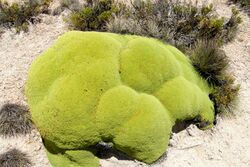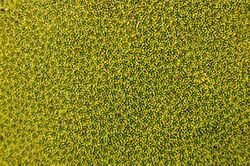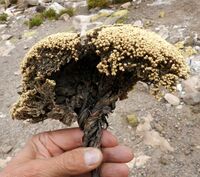Biology:Yareta
| Yareta | |
|---|---|

| |
| in Lauca National Park, Chile | |
| Scientific classification | |
| Kingdom: | Plantae |
| Clade: | Tracheophytes |
| Clade: | Angiosperms |
| Clade: | Eudicots |
| Clade: | Asterids |
| Order: | Apiales |
| Family: | Apiaceae |
| Genus: | Azorella |
| Species: | A. compacta
|
| Binomial name | |
| Azorella compacta Phil.
| |
Yareta or llareta (Azorella compacta, known historically as Azorella yareta, from yarita in the Quechua language) is a velvety, chartreuse cushion plant in the family Apiaceae which is native to South America. It grows in the Puna grasslands of the Andes in Peru, Bolivia, northern Chile and western Argentina at altitudes between 3,200 and 5,250 metres (10,500 and 17,220 ft).[1][2]
Description
Yareta is an evergreen perennial with a low, mat-like shape and hemispherical growth form that grows to around 6 m (20 ft) in diameter.[3] The self-fertile, pink or lavender flowers are hermaphroditic and are primarily pollinated by small flies in the order Diptera, as well as a variety of other small insect species, including bees, wasps, and moths.[4]
The plant prefers sandy, well-drained soils. It can grow in nutritionally poor soils that are acidic, neutral or basic (alkaline) at altitudes of up to 5,200 metres (17,100 ft).[2] Yareta is well-adapted to high insolation rates typical of the Andes highlands and cannot grow in shade. The plant's leaves grow into an extremely compact, dense mat that reduces heat and water loss.[5] This mat grows near the ground where air temperature is one or two degrees Celsius higher than the mean air temperature. This temperature difference is a result of the longwave radiation re-radiated by the soil surface, which is usually dark gray to black in the Puna.[5]
Yareta is estimated to grow approximately 1.5 centimetres (0.59 in) per year.[2] Many yaretas are estimated to be over 3,000 years old.[6] These oldest ones have been reported to grow as slowly as 1⁄18 inch (1.4 millimeters) per year.[7] Its very slow growth makes the traditional practice of harvesting it for fuel highly unsustainable.[8]
Gallery
References
- ↑ "Image of Azorella compacta". chileflora. http://www.chileflora.com/Florachilena/FloraEnglish/HighResPages/EH2013.htm.
- ↑ 2.0 2.1 2.2 Kleier, Catherine; Rundel, Philip W. (August 2004). "Microsite requirements, population structure and growth of the cushion plant Azorella compacta in the tropical Chilean Andes". Austral Ecology 29 (4): 461–470. doi:10.1111/j.1442-9993.2004.01386.x.
- ↑ Pugnaire, Francisco I.; Morillo, José A.; Rodríguez-Echeverría, Susana; Gaxiola, Aurora (February 2020). "Azorella compacta : survival champions in extreme, high‐elevation environments". Ecosphere 11 (2). doi:10.1002/ecs2.3031.
- ↑ López-Sepúlveda, Patricio; Takayama, Koji; Greimler, Josef; Crawford, Daniel J.; Peñailillo, Patricio; Baeza, Marcelo; Ruiz, Eduardo; Kohl, Gudrun et al. (2014-10-08). "Progressive migration and anagenesis in Drimys confertifolia of the Juan Fernández Archipelago, Chile". Journal of Plant Research 128 (1): 73–90. doi:10.1007/s10265-014-0666-7. ISSN 0918-9440. PMID 25292282. PMC 4300435. http://dx.doi.org/10.1007/s10265-014-0666-7.
- ↑ 5.0 5.1 Wickens, G. E. (April 1995). "Llareta (Azorella Compacta, Umbelliferae): A review" (in en). Economic Botany 49 (2): 207–212. doi:10.1007/BF02862926. ISSN 0013-0001.
- ↑ Stenger, Richard (2019-11-28). "The oldest living things on Earth" (in en). https://www.cnn.com/travel/article/oldest-living-things/index.html.
- ↑ Ralph, Carol P. (March 1978). "Observations on Azorella compacta (Umbelliferae)". Biotropica 10 (1): 62 plus photo p. 63. doi:10.2307/2388107.
- ↑ "See the world's oldest organisms". https://www.newscientist.com/gallery/oldest-things/3.
External links
Wikidata ☰ Q551995 entry
 |






